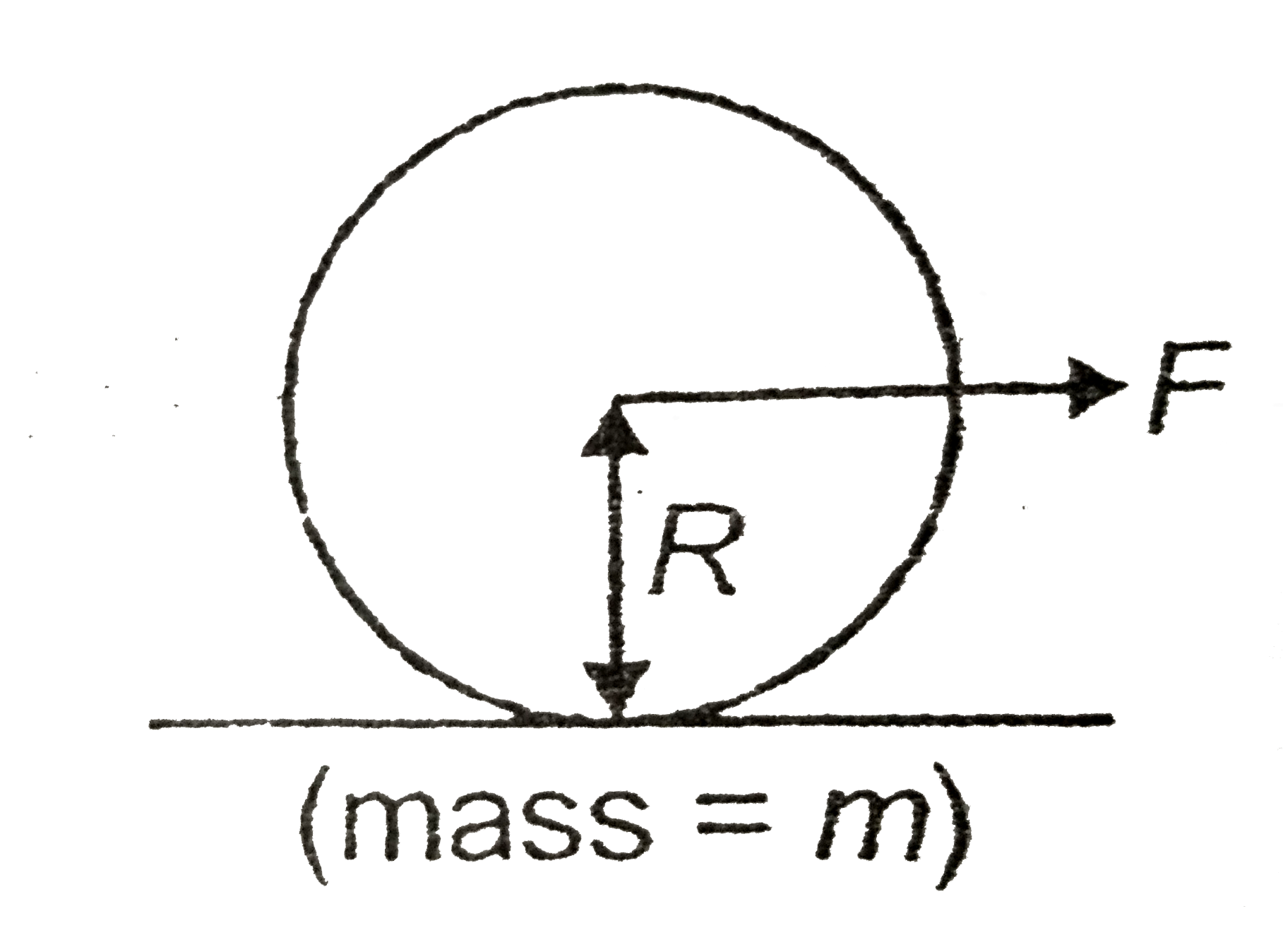Derive an expression for the acceleration of a solid cylinder rolling without slipping down an inclined plane. Also find the minimum coefficient of friction required for pure rolling
To derive the expression for the acceleration of a solid cylinder rolling without slipping down an inclined plane and to find the minimum coefficient of friction required for pure rolling, we can follow these steps:
Step 1: Identify the Forces Acting on the Cylinder
When a solid cylinder rolls down an inclined plane at an angle θ, the forces acting on it are:
- The gravitational force mg acting downward.
- The normal force N acting perpendicular to the inclined plane.
- The frictional force f acting up the incline.
The gravitational force can be resolved into two components:
- Parallel to the incline: mgsinθ
- Perpendicular to the incline: mgcosθ
Step 2: Write the Equation of Motion
Using Newton's second law, we can write the equation for the motion of the cylinder along the incline:
mgsinθ−f=ma
where a is the linear acceleration of the center of mass of the cylinder.
Step 3: Relate Linear and Angular Acceleration
For rolling without slipping, the linear acceleration a and the angular acceleration α are related by:
a=αr
where r is the radius of the cylinder.
Step 4: Write the Torque Equation
The torque τ about the center of mass due to the frictional force is given by:
τ=f⋅r
This torque is also related to the angular acceleration:
τ=Iα
where I is the moment of inertia of the cylinder. For a solid cylinder, I=12mr2.
Substituting α from the linear acceleration relation:
f⋅r=I⋅ar
Substituting I:
f⋅r=12mr2⋅ar
This simplifies to:
f=12ma
Step 5: Substitute f in the Equation of Motion
Now, substitute f into the equation of motion:
mgsinθ−12ma=ma
Rearranging gives:
mgsinθ=ma+12ma
mgsinθ=32ma
Solving for a:
a=23gsinθ
Step 6: Find the Minimum Coefficient of Friction
For pure rolling, the frictional force must not exceed the maximum static friction. The maximum static friction is given by:
fmax=μN=μmgcosθ
From our earlier result, we have:
f=12ma=12m(23gsinθ)=13mgsinθ
Setting f≤fmax:
13mgsinθ≤μmgcosθ
Cancelling mg from both sides:
13sinθ≤μcosθ
Thus, the minimum coefficient of friction is:
μ≥tanθ3
Final Results
1. The acceleration of the solid cylinder rolling down the incline is:
a=23gsinθ
2. The minimum coefficient of friction required for pure rolling is:
μmin=tanθ3
When a solid cylinder rolls down an inclined plane at an angle θ, the forces acting on it are:
- The gravitational force mg acting downward.
- The normal force N acting perpendicular to the inclined plane.
- The frictional force f acting up the incline.
- Parallel to the incline: mgsinθ
- Perpendicular to the incline: mgcosθ
Using Newton's second law, we can write the equation for the motion of the cylinder along the incline:
mgsinθ−f=ma
where a is the linear acceleration of the center of mass of the cylinder.
For rolling without slipping, the linear acceleration a and the angular acceleration α are related by:
a=αr
where r is the radius of the cylinder.
The torque τ about the center of mass due to the frictional force is given by:
τ=f⋅r
This torque is also related to the angular acceleration:
τ=Iα
where I is the moment of inertia of the cylinder. For a solid cylinder, I=12mr2.
f⋅r=I⋅ar
Substituting I:
f⋅r=12mr2⋅ar
This simplifies to:
f=12ma
Now, substitute f into the equation of motion:
mgsinθ−12ma=ma
Rearranging gives:
mgsinθ=ma+12ma
mgsinθ=32ma
Solving for a:
a=23gsinθ
For pure rolling, the frictional force must not exceed the maximum static friction. The maximum static friction is given by:
fmax=μN=μmgcosθ
From our earlier result, we have:
f=12ma=12m(23gsinθ)=13mgsinθ
Setting f≤fmax:
13mgsinθ≤μmgcosθ
Cancelling mg from both sides:
13sinθ≤μcosθ
Thus, the minimum coefficient of friction is:
μ≥tanθ3
1. The acceleration of the solid cylinder rolling down the incline is:
a=23gsinθ
2. The minimum coefficient of friction required for pure rolling is:
μmin=tanθ3
Topper's Solved these Questions
- BOOK - VMC MODULES ENGLISHCHAPTER - ROTATIONAL MOTION EXERCISE - LEVEL - 145videos
ROTATIONAL MOTION
- BOOK - VMC MODULES ENGLISHCHAPTER - ROTATIONAL MOTION EXERCISE - LEVEL - 1 (Angular Momentum, Collision)15videos
ROTATIONAL MOTION
- BOOK - VMC MODULES ENGLISHCHAPTER - ROTATIONAL MOTION EXERCISE - LEVEL-0 (SA-II Short Answer Type -II)12videos
ROTATIONAL MOTION
- BOOK - VMC MODULES ENGLISHCHAPTER - REVISION TEST-2 JEEEXERCISE - PHYSICS25videos
REVISION TEST-2 JEE
- BOOK - VMC MODULES ENGLISHCHAPTER - SIMPLE HARMONIC MOTION EXERCISE - 7-previous year question46videos
SIMPLE HARMONIC MOTION
Similar Questions
If a solid cylinder rolls without slipping on an inclined plane of inclination '0' then the minimum coefficient of friction required to support pure rolling is
View SolutionIf a solid cylinder rolls without slipping on an inclined plane of inclination 45°, then the minimum coefficient of friction required to support pure rolling is
View Solution
Knowledge Check
- Question 1 - Select One
A solid cylinder rolls without slipping down a 30∘ slope. The minimum coefficient of friction needed to prevent slipping, will be
A0.192B0.18C0.15D0.2
A solid sphere of mass m rolls without slipping on an inlined plane of inclination 0. what shoul be the minimum coefficient of static feiction to support pure rolling?
View SolutionA solid cylinder is rolling down on an inclined plane of angle θ. The minimum value of the coefficient of friction between the plane and the cylinder to allow pure rolling
View SolutionA hollow cylinder and a solid cylinder are rolling without slipping down an inclined plane, then which of these reaches earlier ?
View SolutionA force F is applied on a disc at it's centre. Find acceleration of center of mass in the case of pure rolling and also find minimum coefficient of fricition required for pure rolling.
 View Solution
View SolutionA solid cylinder is rolling down a rough inclined plane of inclination θ. Then
View SolutionThe acceleration of a body rolling down on an inclined plane does not depend upon
View SolutionIf a solid cylinder rolls down an inclined plane, then its:
View Solution

